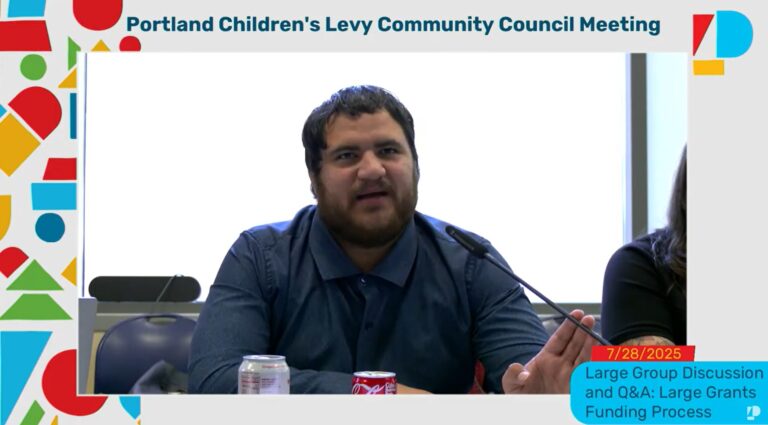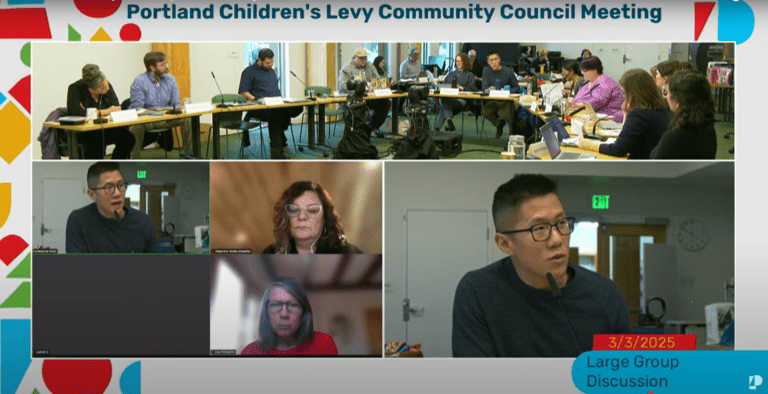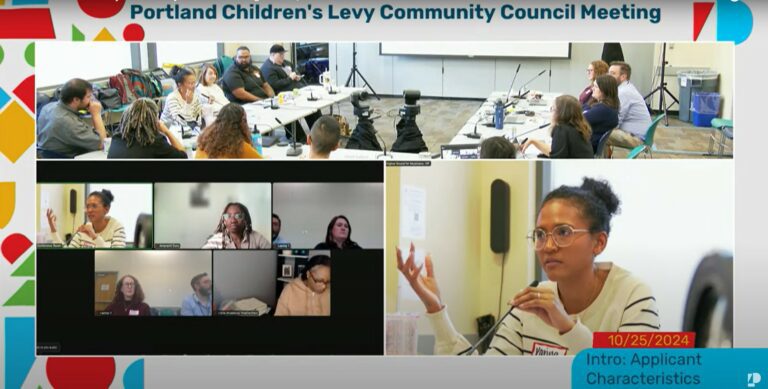Community Council meeting recap (1-24-25)
Welcome to the recap of the Jan. 24, 2025 Community Council meeting. Nine out of 13 members attended the meeting.
Meeting outcomes
- Provide guidance on which application characteristics staff should prioritize to craft two portfolios of applications to recommend for funding.
Meeting summary
To achieve the outcome, council members discussed and voted on 3 questions. The results are listed below and outline the priorities of a majority, or close to a majority, of Community Council members. Of the 9 council members who attended, the number who voted in favor of a priority are listed following each priority. The full results are included at the end of this meeting summary.
1. In general, after score, council members voted to prioritize applications:
- focused on serving Black and Indigenous children and families, and children and families of color (8 of 9)
- from organizations with annual revenues under $6 million (5 of 9)
- focused on serving 1-2 specific racial/ethnic PCL priority populations and/or 1-2 other PCL priority populations (4 of 9)
2. If an application scored at or above the median, council members voted to deprioritize applications:
- from organizations with annual revenues over $18 million (6 of 9)
- serving general/multicultural populations (no specific focus) (6 of 9)
- from current PCL grantees seeking funding for a program PCL doesn’t currently fund (4 of 9)
3. If an application scored below the median, council members voted to prioritize applications:
- from organizations that don’t currently receive PCL funding (5 of 9)
- from organizations with annual revenues under $6 million (5 of 9)
- focused on serving Black and Indigenous children and families, and children and families of color (4 of 9)
- focused on serving 1-2 specific racial/ethnic PCL priority populations and/or 1-2 other PCL priority populations (4 of 9)
In discussion, council members also expressed the desire for staff to create portfolios with a balance of investments across program areas as aligned with allocations previously set by the Allocation Committee.
View the full voting results (PDF)
Staff will use the following factors to craft 2 portfolios of applications recommended for funding:
- Score from community reviewers
- Community Council priorities
- Program feasibility and scale, an organization’s financial health, past performance of current grantees’ programs, and the cost of the proposed program in the context of program scale and size
Staff will present the portfolios to the Community Council on March 3 using descriptive, high-level summary graphics. The Community Council will discuss the two portfolios and vote to recommend one to the Allocation Committee for funding. Throughout the process, the Community Council will not receive identifying applicant information and will not discuss individual applications.
Additional context: score
The three questions council members discussed centered around score. This is because score reflects significant community input and expertise.
- The Community Council spent 3 meetings providing staff with feedback on large grants application questions and scoring criteria. As a result, 70% of the application points focus on how an organization and its proposed program effectively serves PCL priority populations and advances racial equity, diversity, and inclusion.
- In addition, staff recruited and trained 96 community volunteers to read and score 7-8 applications each. Application scores are the median of scores from 4 individual reviewers.
PCL staff recognizes that score-based processes have shortcomings. For example, some applications score highly due to strong grant writing, but the proposed program may have substantial design flaws or performance challenges. Similarly, some applications score low due to lack of grant writing experience, though they may excel in delivering effective programming and services. For this reason, staff will integrate Community Council priorities and the additional factors listed above, along with score, to create funding recommendations.
Additional context: meeting process
A week before the meeting, staff prepared council members by sending them an overview of 2024-25 large grants application data and a guide on the application characteristics. Staff met with small groups of 1-4 council members the week prior to brief them on the data, the process, and the decisions they’d be making.
During the first half of the January 24 meeting, staff reviewed the same material they covered in small groups and spent the remaining three hours conducting an initial poll, pair work, full council discussion, and an official vote.
View the slide deck (PDF — updated Feb. 5, 2025) *
* Corrections to overview of 2024-25 application data slides
After the meeting, staff discovered small errors in 3 slides of data reported to the Community Council. Median scores analyzed by organization size, focus population, and recent PCL funding status mistakenly excluded a small number of scores. The error did not impact the findings identified. For example, median score for applications from organizations with current PCL grants was reported as 129, and median score from applications without PCL grants was reported as 117. The corrected figures based on all applications is 132 for applications from organizations with PCL grants, and 118 for organizations without PCL grants.
Slide 21 was updated Feb. 5, 2025 to correct for transposed figures for the amount of funding available in the mentoring, child abuse prevention and intervention and foster care program areas. The error did not impact the findings identified.
While the errors are small, the slides (PDF) have been corrected.


